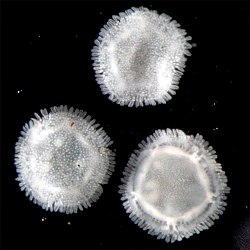| Sea daisies | |
|---|---|

| |
| Xyloplax janetae | |
| Scientific classification | |
| Kingdom: | Animalia |
| Phylum: | Echinodermata |
| Class: | Asteroidea |
| Infraclass: | Concentricycloidea Baker, Rowe & Clark, 1986 |
| Order: | Peripodida Baker, Rowe & Clark, 1986 |
| Family: | Xyloplacidae Baker, Rowe & Clark, 1986 |
| Genus: | Xyloplax Baker, Rowe & Clark, 1986 |
| Species | |
Sea daisies (infraclass Concentricycloidea; order Peripodida) make up an unusual group of deep-sea taxa belonging to the phylum Echinodermata, with three species described in the genus Xyloplax. Intestine and anus are absent.
Distribution
[edit]Sea daisies have been discovered in three localities, including deep-sea habitats off New Zealand, the Bahamas and most recently from the northern central Pacific. They have been collected primarily from sunken, deep-sea (1000+ meters) wood. Although known from only a handful of specimens initially, many specimens have now been collected from the Bahamas.
Classification
[edit]Since they were discovered in 1986, their position within the echinoderms has been debated. At first they were placed in a new class, Concentricycloidea, since it was unclear whether they might have affinities with asteroids or ophiuroids. The former view gained acceptance, and since 2006, they are currently considered a sister group to the Infraclass Neoasteroidea, which represents all post-Paleozoic asteroids within the Class Asteroidea.
Class Asteroidea, Infraclass Concentricycloidea, Order Peripoda (or Peripodida), Family Xyloplacidae
- Genus Xyloplax